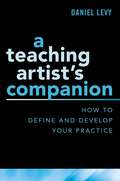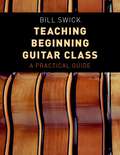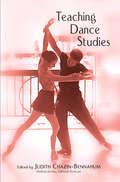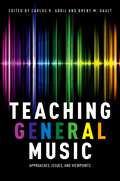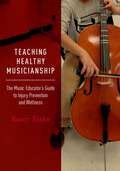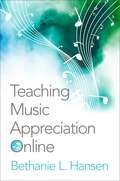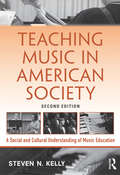- Table View
- List View
TEACHING ARTIST'S COMPANION C: How to Define and Develop Your Practice
by Daniel LevyYou are an artist, living the artist's life. But you also want to make a difference in the world as a teaching artist. You know how to pursue excellence in your art form; how can you pursue excellence in teaching artistry? A Teaching Artist's Companion: How to Define and Develop Your Practice is a how-to reference for veteran and beginning teaching artists alike. Artist-educator Daniel Levy has been working in classrooms, homeless shelters and correctional facilities for over thirty years. With humor and hard-won insight, Levy and a variety of contributing teaching artists narrate their successes and failures while focusing on the practical mechanics of working within conditions of limited time and resources. Levy organizes teaching artist practice within a framework of View, Design, and Respond. View is everything you value and believe about teaching and learning; Design is what you plan before you go into a classroom; Respond is how you react to and support your students face to face. With the aid of checklists, worksheets, and primary sources, A Teaching Artist's Companion invites you to define your own unique view, and guides your observing, critiquing, and shaping your practice over time.
Teaching Beginning Guitar Class: A Practical Guide
by Bill SwickAs guitar instruction increases in popularity in secondary schools, many band, choir, and orchestra teachers are asked to teach guitar. In one helpfully concise volume, Teaching Beginning Guitar Class: A Practical Guide provides all of the practical tools that are necessary to teach guitar in the classroom, especially for music instructors who are not guitar specialists. Formatted to follow the school year from summer planning to opening weeks of the fall semester to a week-to-week timeline for the full school year, Teaching Beginning Guitar Class encompasses all possible needs for a non-guitar playing music instructor navigating the world of guitar instruction in a classroom setting. In twelve expertly organized chapters, author and veteran guitar teacher Bill Swick gives hard and fast guides for instruction, providing reassurance alongside invaluable tips for novice guitar educators. This book addresses questions such as 'I Do Not Play Guitar, Why Do I have to Teach Guitar?'; 'What is the Classroom Lifespan of a Guitar?'; and 'New Students in January?' while also providing practical solutions including basic setup, how to select the correct method book, and equipment maintenance.
TEACHING BEGINNING GUITAR CLASS C: A Practical Guide
by Bill SwickAs guitar instruction increases in popularity in secondary schools, many band, choir, and orchestra teachers are asked to teach guitar. In one helpfully concise volume, Teaching Beginning Guitar Class: A Practical Guide provides all of the practical tools that are necessary to teach guitar in the classroom, especially for music instructors who are not guitar specialists. Formatted to follow the school year from summer planning to opening weeks of the fall semester to a week-to-week timeline for the full school year, Teaching Beginning Guitar Class encompasses all possible needs for a non-guitar playing music instructor navigating the world of guitar instruction in a classroom setting. In twelve expertly organized chapters, author and veteran guitar teacher Bill Swick gives hard and fast guides for instruction, providing reassurance alongside invaluable tips for novice guitar educators. This book addresses questions such as 'I Do Not Play Guitar, Why Do I have to Teach Guitar?'; 'What is the Classroom Lifespan of a Guitar?'; and 'New Students in January?' while also providing practical solutions including basic setup, how to select the correct method book, and equipment maintenance.
Teaching Bob Dylan: "Multitudes"
by Barry J. Faulk and Brady HarrisonTeaching Bob Dylan offers educators practical, adaptable strategies for designing or updating courses (or units within courses) on the life, music, career, and critical reception of Bob Dylan. Drawing on the latest pedagogical developments and best classroom practices in a range of fields, the contributors present concrete approaches for teaching not only Dylan's lyrics and music, but also his many-and sometimes abrupt or unexpected-changes in musical direction, numerous creative guises, and writings. Situating Dylan and his work in their musical, literary, historical, and cultural contexts, the essays explore ways to teach Dylan's connections to African American music and performers, American popular music, the Beats, Christianity, and the revolutions of the 1960s, and more, and offer strategies for incorporating, and analyzing, not only documentaries and films about or featuring Dylan, but also critical and biographical studies on multiple dimensions of an American icon's long and complex career.
Teaching Bob Dylan: "Multitudes"
Teaching Bob Dylan offers educators practical, adaptable strategies for designing or updating courses (or units within courses) on the life, music, career, and critical reception of Bob Dylan. Drawing on the latest pedagogical developments and best classroom practices in a range of fields, the contributors present concrete approaches for teaching not only Dylan's lyrics and music, but also his many-and sometimes abrupt or unexpected-changes in musical direction, numerous creative guises, and writings. Situating Dylan and his work in their musical, literary, historical, and cultural contexts, the essays explore ways to teach Dylan's connections to African American music and performers, American popular music, the Beats, Christianity, and the revolutions of the 1960s, and more, and offer strategies for incorporating, and analyzing, not only documentaries and films about or featuring Dylan, but also critical and biographical studies on multiple dimensions of an American icon's long and complex career.
Teaching Dance Studies
by Judith Chazin-BennahumTeaching Dance Studies is a practical guide, written by college professors and dancers/choreographers active in the field, introducing key issues in dance pedagogy. Many young people graduating from universities with degrees – either PhDs or MFAs – desire to teach dance, either in college settings or at local dance schools. This collection covers all areas of dance education, including improvisation/choreography; movement analysis; anthropology; theory; music for dance; dance on film; kinesiology/injury prevention; notation; history; archiving; and criticism. Among the contributors included in the volume are: Bill Evans, writing on movement analysis; Susan Foster on dance theory; Ilene Fox on notation; Linda Tomko addresses new approaches to teaching the history of all types of dance; and Elizabeth Aldrich writing on archiving.
Teaching Dance Studies
by Judith Chazin-Bennahum Melinda JordanTeaching Dance Studies is a practical guide, written by college professors and dancers/choreographers active in the field, introducing key issues in dance pedagogy. Many young people graduating from universities with degrees – either PhDs or MFAs – desire to teach dance, either in college settings or at local dance schools. This collection covers all areas of dance education, including improvisation/choreography; movement analysis; anthropology; theory; music for dance; dance on film; kinesiology/injury prevention; notation; history; archiving; and criticism. Among the contributors included in the volume are: Bill Evans, writing on movement analysis; Susan Foster on dance theory; Ilene Fox on notation; Linda Tomko addresses new approaches to teaching the history of all types of dance; and Elizabeth Aldrich writing on archiving.
Teaching Electronic Music: Cultural, Creative, and Analytical Perspectives (Modern Musicology and the College Classroom)
by Blake StevensTeaching Electronic Music: Cultural, Creative, and Analytical Perspectives offers innovative and practical techniques for teaching electronic music in a wide range of classroom settings. Across a dozen essays, an array of contributors—including practitioners in musicology, art history, ethnomusicology, music theory, performance, and composition—reflect on the challenges of teaching electronic music, highlighting pedagogical strategies while addressing questions such as: What can instructors do to expand and diversify musical knowledge? Can the study of electronic music foster critical reflection on technology? What are the implications of a digital culture that allows so many to be producers of music? How can instructors engage students in creative experimentation with sound? Electronic music presents unique possibilities and challenges to instructors of music history courses, calling for careful attention to creative curricula, historiographies, repertoires, and practices. Teaching Electronic Music features practical models of instruction as well as paths for further inquiry, identifying untapped methodological directions with broad interest and wide applicability.
Teaching Electronic Music: Cultural, Creative, and Analytical Perspectives (Modern Musicology and the College Classroom)
by Blake StevensTeaching Electronic Music: Cultural, Creative, and Analytical Perspectives offers innovative and practical techniques for teaching electronic music in a wide range of classroom settings. Across a dozen essays, an array of contributors—including practitioners in musicology, art history, ethnomusicology, music theory, performance, and composition—reflect on the challenges of teaching electronic music, highlighting pedagogical strategies while addressing questions such as: What can instructors do to expand and diversify musical knowledge? Can the study of electronic music foster critical reflection on technology? What are the implications of a digital culture that allows so many to be producers of music? How can instructors engage students in creative experimentation with sound? Electronic music presents unique possibilities and challenges to instructors of music history courses, calling for careful attention to creative curricula, historiographies, repertoires, and practices. Teaching Electronic Music features practical models of instruction as well as paths for further inquiry, identifying untapped methodological directions with broad interest and wide applicability.
Teaching General Music: Approaches, Issues, and Viewpoints
General music is informed by a variety of teaching approaches and methods. These pedagogical frameworks guide teachers in planning and implementing instruction. Established approaches to teaching general music must be understood, critically examined, and possibly re-imagined for their potential in school and community music education programs. Teaching General Music brings together the top scholars and practitioners in general music education to create a panoramic view of general music pedagogy and to provide critical lenses through which to view these frameworks. The collection includes an examination of the most prevalent approaches to teaching general music, including Dalcroze, Informal Learning, Interdisciplinary, Kodály, Music Learning Theory, Orff Schulwerk, Social Constructivism, and World Music Pedagogy. In addition, it provides critical analyses of general music and teaching systems, in light of the ways children around the world experience music in their lives. Rather than promoting or advocating for any single approach to teaching music, this book presents the various approaches in conversation with one another. Highlighting the perceived and documented benefits, limits, challenges, and potentials of each, Teaching General Music offers myriad lenses through which to re-read, re-think, and re-practice these approaches.
TEACHING GENERAL MUSIC C: Approaches, Issues, and Viewpoints
by Carlos R. Abril and Brent M. GaultGeneral music is informed by a variety of teaching approaches and methods. These pedagogical frameworks guide teachers in planning and implementing instruction. Established approaches to teaching general music must be understood, critically examined, and possibly re-imagined for their potential in school and community music education programs. Teaching General Music brings together the top scholars and practitioners in general music education to create a panoramic view of general music pedagogy and to provide critical lenses through which to view these frameworks. The collection includes an examination of the most prevalent approaches to teaching general music, including Dalcroze, Informal Learning, Interdisciplinary, Kodály, Music Learning Theory, Orff Schulwerk, Social Constructivism, and World Music Pedagogy. In addition, it provides critical analyses of general music and teaching systems, in light of the ways children around the world experience music in their lives. Rather than promoting or advocating for any single approach to teaching music, this book presents the various approaches in conversation with one another. Highlighting the perceived and documented benefits, limits, challenges, and potentials of each, Teaching General Music offers myriad lenses through which to re-read, re-think, and re-practice these approaches.
Teaching Healthy Musicianship: The Music Educator's Guide to Injury Prevention and Wellness
by Nancy TaylorWritten by a professional musician who is also a certified occupational therapist, Teaching Healthy Musicianship first and foremost help music educators avoid common injuries that they themselves encounter, and in the process it also equips them with the tools they need to instill healthy musicianship practices in their students. Author Nancy Taylor combines her two unique skill sets to provide a model for injury prevention that is equally cognizant of the needs of music educators and their students. Through practical explanation of body mechanics, ergonomics, and the performance-related health problems and risk factors unique to musicianship, she gives music educators the tools they need to first practice healthy posture, body mechanics, environmental safety, and ergonomics, and then to introduce these same practices to their students. Thoroughly illustrated with 125 photographs, this book is a key resource for preservice and inservice teachers of middle school and high school band, orchestra, choir and general music.
Teaching Healthy Musicianship: The Music Educator's Guide to Injury Prevention and Wellness
by Nancy TaylorWritten by a professional musician who is also a certified occupational therapist, Teaching Healthy Musicianship first and foremost help music educators avoid common injuries that they themselves encounter, and in the process it also equips them with the tools they need to instill healthy musicianship practices in their students. Author Nancy Taylor combines her two unique skill sets to provide a model for injury prevention that is equally cognizant of the needs of music educators and their students. Through practical explanation of body mechanics, ergonomics, and the performance-related health problems and risk factors unique to musicianship, she gives music educators the tools they need to first practice healthy posture, body mechanics, environmental safety, and ergonomics, and then to introduce these same practices to their students. Thoroughly illustrated with 125 photographs, this book is a key resource for preservice and inservice teachers of middle school and high school band, orchestra, choir and general music.
Teaching Instrumental Music: Contemporary Perspectives and Pedagogies
Teaching Instrumental Music: Contemporary Perspectives and Pedagogies reflects the music pedagogy of recent years while acknowledging traditional instruments and styles. Written by a diverse, expert team of 47 authors, the text covers both the teaching of individual instruments and the teaching of instrumental ensembles. It can serve as the sole comprehensive text to accompany any instrumental music education class, including concert band, jazz band, marching band, strings, and popular music.
Teaching Music: The Urban Experience
by Lisa C DeLorenzoThis timely book explores teaching music in the urban setting along with interviews and journal accounts from urban music teachers in a variety of specializations. Written for pre-service music education students and music teachers new to urban teaching, this is a must-read for those considering teaching in the urban schools. Selected topics include culturally responsive teaching; White teachers working with students of color; nurturing pedagogy for at-risk youths; working with ESL students and immigrant families; creating a democratic and socially just music classroom; and developing habits of teaching that promote resilience and confidence in the emotional, social, and academic well-being of young musicians. A valuable resource for music teaching, this book features an accessible blend of theory and practice with authentic stories from the field.
Teaching Music: The Urban Experience
by Lisa C DeLorenzoThis timely book explores teaching music in the urban setting along with interviews and journal accounts from urban music teachers in a variety of specializations. Written for pre-service music education students and music teachers new to urban teaching, this is a must-read for those considering teaching in the urban schools. Selected topics include culturally responsive teaching; White teachers working with students of color; nurturing pedagogy for at-risk youths; working with ESL students and immigrant families; creating a democratic and socially just music classroom; and developing habits of teaching that promote resilience and confidence in the emotional, social, and academic well-being of young musicians. A valuable resource for music teaching, this book features an accessible blend of theory and practice with authentic stories from the field.
Teaching Music Appreciation Online
by Bethanie L. HansenIn this book, readers will learn practical tips and strategies to teach music appreciation online. As online education is a growing field, an increasing number of teachers trained in traditional/live methods find themselves now teaching online and potentially without mentors to assist them. Students are also changing, seeking highly engaged, relevant, and interactive learning opportunities that connect to their lives. Here, readers will find helpful guidance in planning curriculum, integrating multimedia assets, designing forum discussions, developing assignments, preparing rubrics, engaging in forum discussions, preparing, managing, and teaching, the course, providing feedback and grading, and following up with struggling and challenging students. The book can serve as a resource to those already teaching music appreciation online or as a comprehensive guide to those new to the field. Additionally, it may serve as a resource to instructors in other disciplines who seek to shift live-courses to the online format, as well as music appreciation instructors who would like to integrate digital or online components into traditional face-to-face courses. The book is organized into five major sections, designed to guide the novice online educator in depth while also appealing to the seasoned veteran through the ability to review each section as a stand-alone resource. Although some readers will desire to read from cover to cover, they will also be able to move in a non-linear manner from chapter to chapter, using chapters in modular form, in order to benefit from the sections that most apply to them at any given time.
TEACHING MUSIC APPRECIATION ONLINE 2E C
by Bethanie L. HansenIn this book, readers will learn practical tips and strategies to teach music appreciation online. As online education is a growing field, an increasing number of teachers trained in traditional/live methods find themselves now teaching online and potentially without mentors to assist them. Students are also changing, seeking highly engaged, relevant, and interactive learning opportunities that connect to their lives. Here, readers will find helpful guidance in planning curriculum, integrating multimedia assets, designing forum discussions, developing assignments, preparing rubrics, engaging in forum discussions, preparing, managing, and teaching, the course, providing feedback and grading, and following up with struggling and challenging students. The book can serve as a resource to those already teaching music appreciation online or as a comprehensive guide to those new to the field. Additionally, it may serve as a resource to instructors in other disciplines who seek to shift live-courses to the online format, as well as music appreciation instructors who would like to integrate digital or online components into traditional face-to-face courses. The book is organized into five major sections, designed to guide the novice online educator in depth while also appealing to the seasoned veteran through the ability to review each section as a stand-alone resource. Although some readers will desire to read from cover to cover, they will also be able to move in a non-linear manner from chapter to chapter, using chapters in modular form, in order to benefit from the sections that most apply to them at any given time.
Teaching Music History
by Mary NatvigUnlike their colleagues in music theory and music education, teachers of music history have tended not to commit their pedagogical ideas to print. This collection of essays seeks to help redress the balance, providing advice and guidance to those who teach a college-level music history or music appreciation course, be they a graduate student setting out on their teaching career, or a seasoned professor having to teach outside his or her speciality. Divided into four sections, the book covers the basic music history survey usually taken by music majors; music appreciation and introductory courses aimed at non-majors; special topic courses such as women and music, music for film and American music; and more general issues such as writing, using anthologies, and approaches to teaching in various situations. In addition to these specific areas, broader themes emerge across the essays. These include how to integrate social history and cultural context into music history teaching; the shift away from the 'classical canon'; and how to organize a course taking into consideration time constraints and the need to appeal to students from a diverse range of backgrounds. With contributions from both teachers approaching retirement and those at the start of their careers, this volume provides a spectrum of experience which will prove valuable to all teachers of music history.
Teaching Music History
by Mary NatvigUnlike their colleagues in music theory and music education, teachers of music history have tended not to commit their pedagogical ideas to print. This collection of essays seeks to help redress the balance, providing advice and guidance to those who teach a college-level music history or music appreciation course, be they a graduate student setting out on their teaching career, or a seasoned professor having to teach outside his or her speciality. Divided into four sections, the book covers the basic music history survey usually taken by music majors; music appreciation and introductory courses aimed at non-majors; special topic courses such as women and music, music for film and American music; and more general issues such as writing, using anthologies, and approaches to teaching in various situations. In addition to these specific areas, broader themes emerge across the essays. These include how to integrate social history and cultural context into music history teaching; the shift away from the 'classical canon'; and how to organize a course taking into consideration time constraints and the need to appeal to students from a diverse range of backgrounds. With contributions from both teachers approaching retirement and those at the start of their careers, this volume provides a spectrum of experience which will prove valuable to all teachers of music history.
Teaching Music History with Cases: A Teacher's Guide (Modern Musicology and the College Classroom)
by Sara HaefeliTeaching Music History with Cases introduces a pedagogical approach to music history instruction in university coursework. What constitutes a music-historical "case?" How do we use them in the classroom? In business and the hard sciences, cases are problems that need solutions. In a field like music history, a case is not always a problem, but often an exploration of a context or concept that inspires deep inquiry. Such cases are narratives of rich, complex moments in music history that inspire questions of similar or related moments. This book guides instructors through the process of designing a curriculum based on case studies, finding and writing case studies, and guiding class discussions of cases.
Teaching Music History with Cases: A Teacher's Guide (Modern Musicology and the College Classroom)
by Sara HaefeliTeaching Music History with Cases introduces a pedagogical approach to music history instruction in university coursework. What constitutes a music-historical "case?" How do we use them in the classroom? In business and the hard sciences, cases are problems that need solutions. In a field like music history, a case is not always a problem, but often an exploration of a context or concept that inspires deep inquiry. Such cases are narratives of rich, complex moments in music history that inspire questions of similar or related moments. This book guides instructors through the process of designing a curriculum based on case studies, finding and writing case studies, and guiding class discussions of cases.
Teaching Music Improvisation with Technology
by Michael FeinIncorporating technology in music classrooms can take the mystery out of improvisation. What music technology does is establish a strong foundation for chord, scale, phrase, ear training, and listening exercises, creating a solid backdrop for student expression. As author and educator Mike Fein shows, technology is a valuable tool that can be used effectively to supplement student practice time while also developing the skills necessary to become a proficient improviser. Complete with notated exercises, accompaniment tracks, and listening resources, this book gives teachers methods to set their students free to make mistakes and to develop their own ear for improvisation at their own pace. Broken down into significant areas of music technology, each chapter focuses on developing a new skill and guides readers to tangible outcomes with the assistance of hands-on activities that can be immediately implemented into the classroom. In addition to these hands-on activities, each chapter provides the reader with an "iPad Connection" to various iOS applications, which allows teachers and students another, albeit significantly less expensive, medium through which to learn, share, and create art. This book will appeal to music educators of students in grades K-12. It will serve collegiate music education courses secondarily, and will also appeal to those music educators who work with improvisation and technology.
Teaching Music Improvisation with Technology
by Michael FeinIncorporating technology in music classrooms can take the mystery out of improvisation. What music technology does is establish a strong foundation for chord, scale, phrase, ear training, and listening exercises, creating a solid backdrop for student expression. As author and educator Mike Fein shows, technology is a valuable tool that can be used effectively to supplement student practice time while also developing the skills necessary to become a proficient improviser. Complete with notated exercises, accompaniment tracks, and listening resources, this book gives teachers methods to set their students free to make mistakes and to develop their own ear for improvisation at their own pace. Broken down into significant areas of music technology, each chapter focuses on developing a new skill and guides readers to tangible outcomes with the assistance of hands-on activities that can be immediately implemented into the classroom. In addition to these hands-on activities, each chapter provides the reader with an "iPad Connection" to various iOS applications, which allows teachers and students another, albeit significantly less expensive, medium through which to learn, share, and create art. This book will appeal to music educators of students in grades K-12. It will serve collegiate music education courses secondarily, and will also appeal to those music educators who work with improvisation and technology.
Teaching Music in American Society: A Social and Cultural Understanding of Music Education
by Steven N. KellySuccessful professional music teachers must not only be knowledgeable in conducting and performing, but also be socially and culturally aware of students, issues, and events that affect their classrooms. This book provides comprehensive overview of social and cultural themes directly related to music education, teacher training, and successful teacher characteristics. New topics in the second edition include the impact of Race to the Top, social justice, bullying, alternative schools, the influence of Common Core Standards, and the effects of teacher and school assessments. All topics and material are research-based to provide a foundation and current perspective on each issue.
